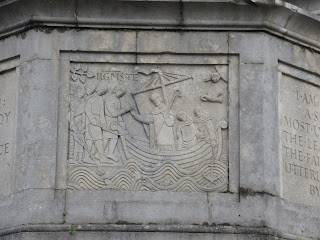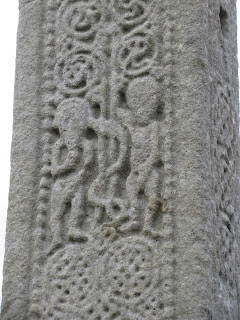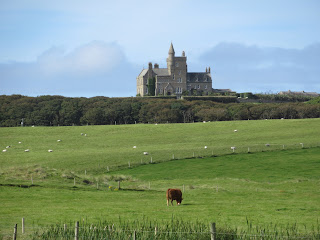We'd arrived too late the night before in Westport on the west coast of Ireland to explore anything of the town so chose to do that in the morning after spending a very relaxing night in the unexpectedly huge Helms B&B. We were excited as it had a combo washer and dryer even if it did take about three hours to run just one load! If we had known in advance how large our accommodation was, how delicious the free breakfast was and, more importantly, how charming Westport and the surrounding was, I think we would have added another day at least to stay there!

I thought it was very odd that the monument was inscribed, "I am Patrick, a sinner most unlearned, the least of all the faithful, and utterly despised by all." Did it perhaps refer to St. Patrick's extreme humility?
The Doris Brothers Bridge was named in honor of the founders of The Mayo News who campaigned for tenant rights and the freedom of Ireland in 1892. Both were imprisoned for their political activities.
Yeats died in France during WW II but it wasn't until 1948 that his body was interred at Drumcliffe where his great-grandfather had been a rector. The year before he died, Yeats composed his epitaph, the last line of which was:
"Cast a cold aye
on life, On Death
Horseman pass by."
Workhouse life was controlled by routine and regulations so that certain times were set aside for sleeping, eating, exercise and working. The type of work was limited; one job for men was stone breaking so that stones could then be used for building or repairing roads. Officials supervised all jobs.
Workhouse regulations stipulated that no paupers could consume tobacco, fermented liquor or any food other than provided. Furthermore, no written or printed paper "of an improper tendency" could be circulated or read aloud among the inmates of the workhouse; no cards or other game of chance could be played, etc.
The daily diet for adults and children over 13 was one-third quart of buttermilk for each meal, plus six ounces of oatmeal for breakfast; three pounds of potatoes for lunch; and five ounces of oatmeal for dinner.
People could only leave the workhouse if they gave the Master three hours' notice and only in entire family units. The Master was in charge of the day-to-day running of the workhouse and to "enforce industry, order, punctuality and cleanliness."

We had a three-bedroom apartment and a huge fully furnished kitchen - the only negative was having to lug our suitcases up lots and lots of stairs, many of them outside!
In this part of Ireland, Westport was considered the 'big city' even though it only had a population of 9,000 people. Unlike most other towns that just 'grew' out of the Middle Ages, Westport was a planned community that was built in the 1700s in the Georgian style by the famous architect James Wyatt to support the English Lord Browne's adjacent estate.
Westport's eight-side main square was naturally called the Octagon and it was the centerpiece of the planned town in the 1760s. Taxes and customs were paid, and trade was organized in the old market house, the big limestone building with the clock.
The monument in the middle of the Octagon was built just before the Great Famine in 1843 to honor Lord Browne's English banker! The statue was destroyed in 1922 by Irish patriots during the country's Civil War. The banker was replaced by St. Patrick attired in Roman clothes after he had been kidnapped.
Just up from the square was a skinny bronze statue that celebrated Westport's being awarded in 2012 "the best town to live in."
As we walked downtown, we noticed there were no stop signs because the town's citizens are "supposed" to be so friendly that pedestrians are always yielded to in a crosswalk without having to be reminded! That did work most every time, we saw, too, although we were a bit leery. There were also no chain stores in the center of town because, by popular demand, the town council refused to allow them.
Across the river and behind the fancy fence was the fancy Anglican Holy Trinity Church that had been constructed for the town's wealthy English Protestants.
On the other side of the bridge was the more humble St. Mary's Catholic Church built in 1813 for the indigenous Catholics.
By the water in front of the church was a bust of Major John MacBride, one of the rebels of the 1916 Easter Rising who was among the 14 men executed at Dublin's Kilmainham Gaol. Visiting that spot in the jail's yard on our second day had been harrowing.
I loved the cheery colors of the shops in Westport. We hadn't seen anything like that since we'd been in southern Ireland.
The clock tower was only from 1947 and was built as people needed a reliable timepiece to set their watches to. Volunteers tended to all the attractive flowers in the square around the tower.
If anyone has a chance to visit this area of Ireland, I hope you'll be lucky enough, unlike us, to bike along part or all of the 26-mile long Great Western Greenway. From 1895-1937, a rail line operated from Westport to Achill Island, but it was replaced by a paved path perfect for bikers.
Since we'd spent so much time exploring charming Westport, we had to beetle north through most of County Sligo without any stops until we reached Drumcliffe Village on the coast. The village is best known as the final resting place of the Irish poet W.B. Yeats. Drumcliffe was a historic spot and a place of pilgrimage because St. Columba founded a monastery here in 574. He and another saint quarreled over the rights to a book which resulted in a battle in which 3,000 people were killed. So saddened by the bloodshed, St. Columba left Ireland for the island of Iona in Scotland where he founded another monastery that became famous as the original home of the striking Book of Kells that we'd seen our first day in Dublin. About a week later we visited Iona to see St. Columba's monastery there. More about it in a future post.
"Cast a cold aye
on life, On Death
Horseman pass by."
In 1809, when the Drumcliffe Mural was painted in the church, the Church of Ireland was going through a phase of being reluctant to have pictures of Jesus or crosses in their churches. As a result, the artist cleverly suggested the Christian faith by means of symbols. The pale yellow background represented the light of heaven with God as the source and being immensely powerful.
On every 'brick' of heaven was a 'fleur de lis,' a traditional symbol of the Holy Trinity. The cross of Jesus was cleverly suggested by the very top cross-shaped twig with red leaves representing blood. The descending dove indicated the presence of the Holy Spirit. The scroll depicted the Scriptures.
The largest symbol was the vine as it portrayed Jesus who said "I am the Vine." I really appreciated how the artist was able to include these and so many other Christian elements in the mural instead of the usual cross and religious paintings I was so accustomed to seeing in every other church.
Outside the church were these two whimsical figures:
Near the church was the High Cross possibly erected in the 11th century by the site of St. Columba's monastery. The cross was carved with reliefs meant to teach the illiterate people Bible lessons. On one side of the remarkable cross was Adam and Eve, Cain slaying Abel, Daniel in the Lions' Den and Christ. On another side were scenes from the New Testament, a camel trying to get through the eye of a needle and two unidentified figures.
Across the highway was a round tower also associated with the thousand-year old monastic settlement. The cross and tower were symbols of medieval Ireland that once dotted the countryside.
A path led from the cross to majestic views of Benulben that inspired Yeats.
Crossing over into County Donegal, we took a side trip around the gorgeous Mullaghmore Head where the IRA detonated a radio-controlled bomb in August of 1979 on the yacht belonging to Lord Mountbatten, the second cousin of the queen, killing him and others.
Mountbatten's Castle:
The charming town of Donegal in the Republic of Ireland's northernmost county was the perfect place to get out and explore. The town's name meant Fort of Foreigners, a reminder that the Vikings invaded the area in the 9th century. The main square, The Diamond, was surrounded by inviting shops and restaurants. It was the former that drew my attention!
Almost gone as we reached the northern part of the island were the Catholic churches so common further south. Here was another Church of Ireland which meant a Protestant church.
Right in the center of town was Donegal Castle, originally the fortified base of the powerful O'Donnell clan and built about 1500. Most of the fortified towers were post 1601 when the English defeated the O'Donnells and asserted their control over the Irish.
Still further north was Glenveaugh National Park, one of the country's six national parks, and home to a castle of the same name built by a wealthy land speculator who bought the valley in 1857. The castle, built on the shore of pristine Lough Veagh, changed hands several times until it was donated to the people of Ireland in 1981. We hoped to catch at least a glimpse of the castle but, even after walking a considerable distance on both sides of the lake's trail, we didn't see any sign of it and had to give up because it was getting late and we still had a long ways to go that day.
Though we missed seeing the castle, these views of the particularly beautiful Lough Veagh made up for it.
The trail was bordered on both sides by these tiny flowers, possibly rhododendrons?
We knew that we missed the chance to see the castle or at least hike more in the national park because of all the time we'd spent that morning in picturesque Westport.
We then made a final push for Dunfanaghy Workhouse located almost as far north north as you can go in Ireland. It was opened about 1845 and was part of an extensive compound with segregated areas for men, women, children and the sick for the utterly destitute of coastal Donegal. The buildings were enclosed by a substantial wall so the paupers couldn't escape while wearing workhouse clothes.
The workhouses were described as a terrible place, a last resort for the poor, with conditions inside worse than outside where the poorest people lived in abject poverty. They were designed to be uniform, cheap and unattractive.
When admitted to the workhouse, people were given a medical exam, a bath and distinctive workhouse clothes. Males and females were separated and further segregated into infants, children and adults. Each had their own area of the workhouse. A family could only enter together but were separated from each other once inside although parents could see their children.
The Matron, below, was responsible for the females.
Our visit to Dunfanaghy was through the eyes of Hannah Herrity who spent her entire life in County Donegal. Born about 1935, she lived for over 90 years, surviving in a harsh and difficult world of work and traveling from one job to another. Part of her life was spent at the workhouse.
Although we didn't get a sense of what the workhouse would have looked like from the current museum, our visit certainly made us aware in very stark terms how desperate so many people's lives were during the famine years to try and enter a workhouse. such as the one at Dunfanaghy.
It was only Steven's eagle eyes who noticed this sign that indicated we had just crossed from the Republic of Ireland and into Northern Ireland, i.e. the part of the island that was part of United Kingdom and included the countries of England, Wales and Scotland. There was no other indication we had crossed from one political entity to another. Crossing over the invisible border meant, in the narrowest sense, the currency had changed from euros to British pounds and that distance markers had changed from kilometers to miles.
It was this invisible border that has been the subject of so much anguish amid the Brexit discussions and has sunk the careers of several recent politicians. We looked forward to discovering for ourselves in the next few days what life was like in Northern Ireland, an area that has seen so many 'Troubles.'
Next post: Derry's City Walls and the Bloody Sunday Murals.
Posted on October 17th, 2019, from yet another unusually hot day in suburban Denver.



















































































Westport is so beautiful and I love the idea of no street signs... just ask a resident :)
ReplyDeletexo Lina in sunny Scottsdale AZ